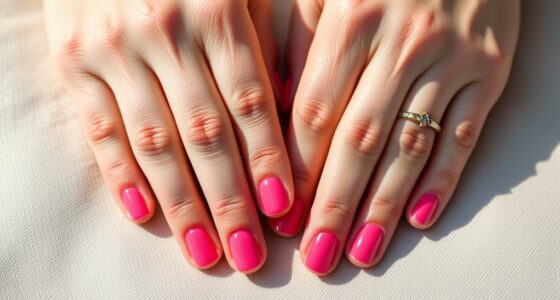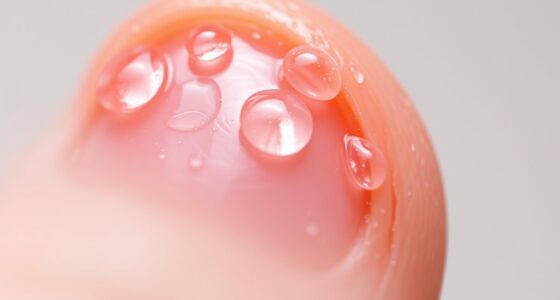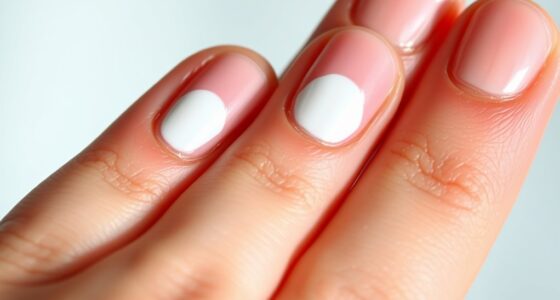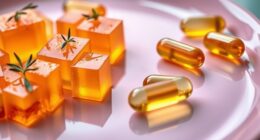Keratin is the tough, fibrous protein that forms the foundation of your nails, giving them strength, flexibility, and resilience. It’s organized in layers and cross-linked bonds that help your nails resist damage and breakage. Your nail growth depends on healthy keratin production, which is influenced by your diet and care habits. Understanding how keratin shapes your nails can help you improve their strength and appearance—keep going to discover more about this essential protein.
Key Takeaways
- Keratin forms the structural foundation of nails, providing strength, resilience, and durability.
- It is organized into densely packed layers with cross-linking bonds that enhance hardness.
- Keratin production occurs in the nail matrix, supporting continuous growth and repair.
- External factors and proper care maintain keratin integrity, preventing damage and infections.
- Nutrition and hydration influence keratin synthesis, impacting overall nail health and flexibility.
What Is Keratin and Why Is It Important for Nails
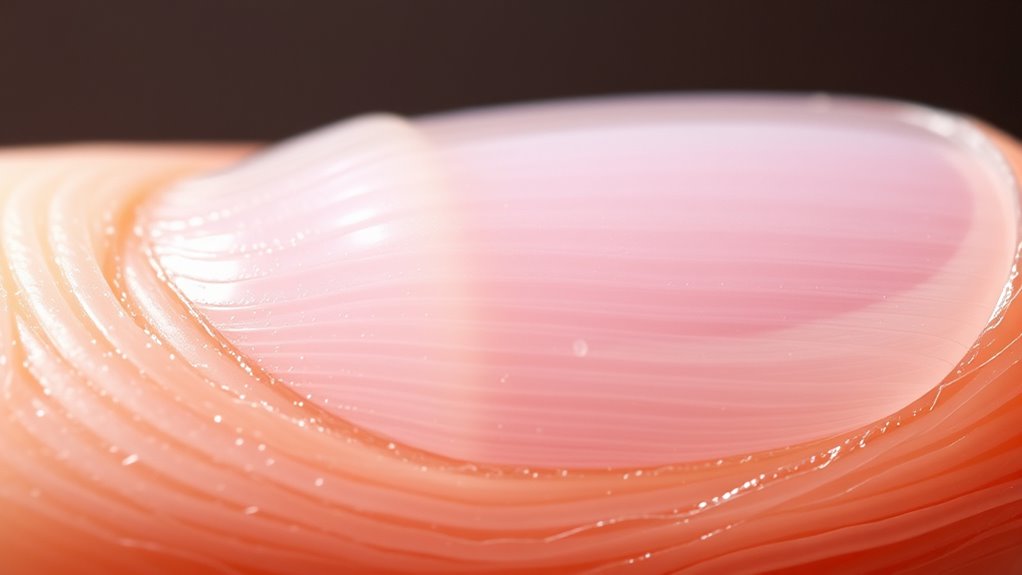
Keratin is a tough, fibrous protein that forms the foundation of your nails. It’s what gives your nails strength, resilience, and durability. Without enough keratin, nails can become brittle, weak, or prone to breaking. When you choose nail polish formulas, you’re applying products that sit on this keratin surface, so the quality of your keratin impacts how well your nails hold polish and resist damage. Salon treatments often aim to boost keratin levels or strengthen the existing keratin structure, helping nails stay healthy and beautiful. Understanding keratin’s role highlights why proper nail care matters. It’s not just about appearance but also about maintaining the integrity of this essential protein that keeps your nails strong and functional every day. Proper nutrition and environmental considerations also support keratin production and overall nail health. Using products with keratin-enriching ingredients can further enhance your nails’ strength and appearance. Additionally, adequate hydration plays a crucial role in maintaining the flexibility and health of keratin in your nails. Recognizing how angel numbers relate to self-care and growth can inspire a holistic approach to maintaining healthy nails and overall well-being.
The Composition and Structure of Nail Keratin

Your nails are made of layers of keratin proteins arranged in a precise structure. This organized setup, along with cross-linking between proteins, gives your nails their strength and durability. Understanding this composition helps explain why nails are both tough and flexible. Additionally, the specific tuning of keratin in nails is similar to how vehicle modifications, such as engine tuning or suspension upgrades, can enhance performance and resilience. The natural cross-linking within keratin fibers can be likened to suspension modifications, which improve a vehicle’s handling and comfort by optimizing the connection between components. Moreover, advances in natural language processing are helping researchers better understand biological structures like keratin, leading to potential innovations in nail health and treatments. As research progresses, we can expect new biomedical applications that further improve nail care and repair techniques.
Protein Layers and Arrangement
Understanding the structure of nail keratin reveals how its layered protein composition provides strength and flexibility. Your nails consist of densely packed keratin proteins arranged in overlapping layers, creating a resilient yet pliable surface. These layers are organized in specific patterns that influence how your nails respond to external factors like nail polish effects and cuticle health. When the cuticle remains healthy, it protects the underlying keratin layers from damage and helps maintain proper protein arrangement. Additionally, maintaining a healthy cuticle prevents damage and infection, which can compromise nail integrity. Conversely, frequent or harsh nail polish removers can disturb this layered structure, weakening the nails over time. The precise organization of keratin proteins allows your nails to withstand daily stresses while remaining flexible enough to resist cracking. This layered arrangement is fundamental to both the durability and beauty of your nails. Layered protein structure plays a crucial role in maintaining nail health and resilience.
Cross-Linking and Hardness
Cross-linking of keratin proteins plays a vital role in determining the hardness of your nails. These bonds form between cysteine amino acids, creating a strong, resilient structure. When your cuticle health is optimal, it supports keratin cross-linking, enhancing nail strength. Proper nail polishing avoids damaging these bonds, maintaining hardness. To illustrate, consider this table:
| Factor | Effect on Nail Hardness |
|---|---|
| Healthy cuticle | Supports keratin structure |
| Excessive polishing | Can weaken cross-linking |
| Hydration levels | Maintain flexibility and strength |
| Aging | Reduces cross-link density |
How Keratin Contributes to Nail Strength and Flexibility

Keratin gives your nails their overall strength, helping them resist breaking and damage. At the same time, it provides a degree of flexibility, so your nails don’t crack easily under pressure. Finding the right balance between these qualities is key to healthy, durable nails. Additionally, paint application techniques can influence nail health by reducing stress on the keratin structure during manicures.
Keratin’s Structural Role
Keratin’s unique molecular structure plays an essential role in giving your nails both strength and flexibility. This protein forms tightly packed filaments that create a resilient yet adaptable framework. When you apply nail polish or engage in nail art, keratin’s durability helps protect your nails from damage while allowing some flexibility to prevent cracking. Additionally, understanding the structural properties of keratin can help in choosing the right nail care routines. For example, material strength influences how well your nails resist fractures and damage over time. The composition of keratin includes various amino acids that contribute to its mechanical properties, further enhancing nail durability. The presence of disulfide bonds within keratin molecules also plays a crucial role in providing additional structural stability, making nails more resistant to breakage. Here are three ways keratin supports your nails:
- It provides a tough outer layer that resists fractures during daily activities.
- Its flexible fibers help prevent brittleness, even with frequent nail art applications.
- The interconnected keratin proteins maintain a resilient structure, balancing strength with gentle bendability.
This structural role ensures your nails stay durable yet flexible, making them perfect canvases for nail polish and nail art.
Balancing Strength and Flexibility
The unique molecular design of keratin allows your nails to strike a balance between strength and flexibility. This balance is essential for maintaining nail aesthetics while preventing brittleness or breakage. When keratin’s structure is ideal, your nails withstand daily stress and minor impacts. Cosmetic treatments often enhance this natural balance, improving both appearance and durability. To understand this better, consider the following: A well-maintained keratin matrix also supports nail resilience, helping nails recover from minor damages more effectively. Additionally, the structural properties of keratin are vital in defining how nails respond to environmental factors and physical stress. Recognizing the significance of protein composition in keratin can further aid in choosing appropriate nail care routines. A deeper appreciation of molecular structure can optimize strategies for nail health and longevity.
The Nail Growth Process and Keratin’s Role
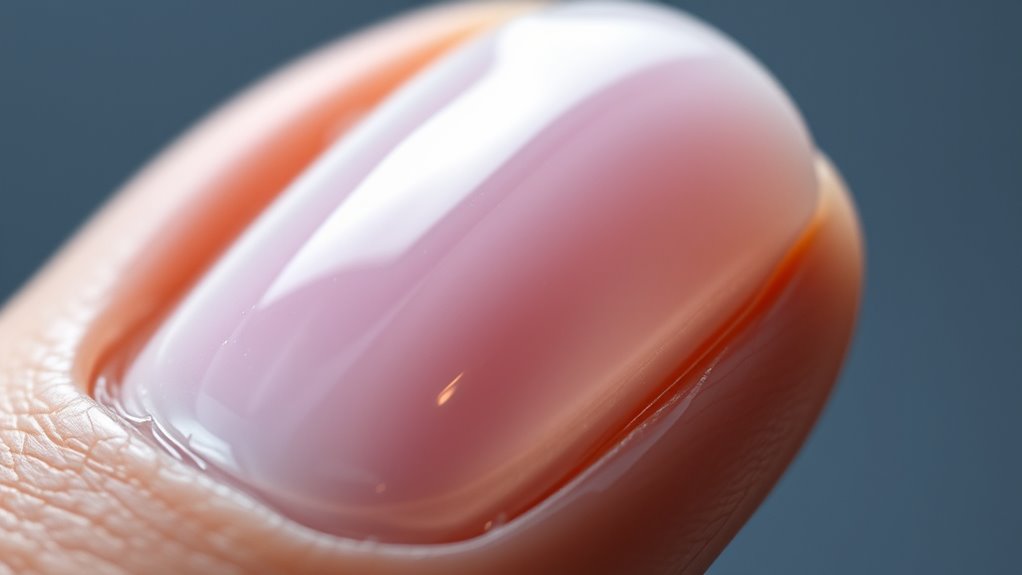
As your nails grow, a complex process unfolds beneath the surface, driven by the production of keratin. This protein forms the foundation of your nail structure, ensuring strength and resilience. The nail matrix, located under your cuticle, is where keratin production begins, pushing new cells outward. As these cells mature, they harden into the nail you see. During this process, proper nail care is essential—applying nail polish or practicing specific manicure techniques can protect your nails and promote healthy growth.
- Regularly moisturizing your cuticles supports keratin formation.
- Avoiding harsh chemicals prevents damage to growing nails.
- Gentle filing and careful removal of old polish encourage healthy nail development.
Factors That Affect Keratin Production in Nails

Several factors can influence how well your nails produce keratin, affecting their overall strength and health. Poor cuticle care can hinder keratin synthesis, making nails weak and prone to damage. Frequent nail art or harsh chemicals may also weaken keratin layers. Additionally, nail hygiene impacts keratin production by preventing infections that disrupt growth. Consuming a balanced diet rich in vitamins and minerals supports the natural keratin synthesis process, which is essential for healthy nail growth. Using quality products can help maintain healthy keratin levels and improve nail strength.
Nutrition and Lifestyle Tips to Support Healthy Keratin Levels
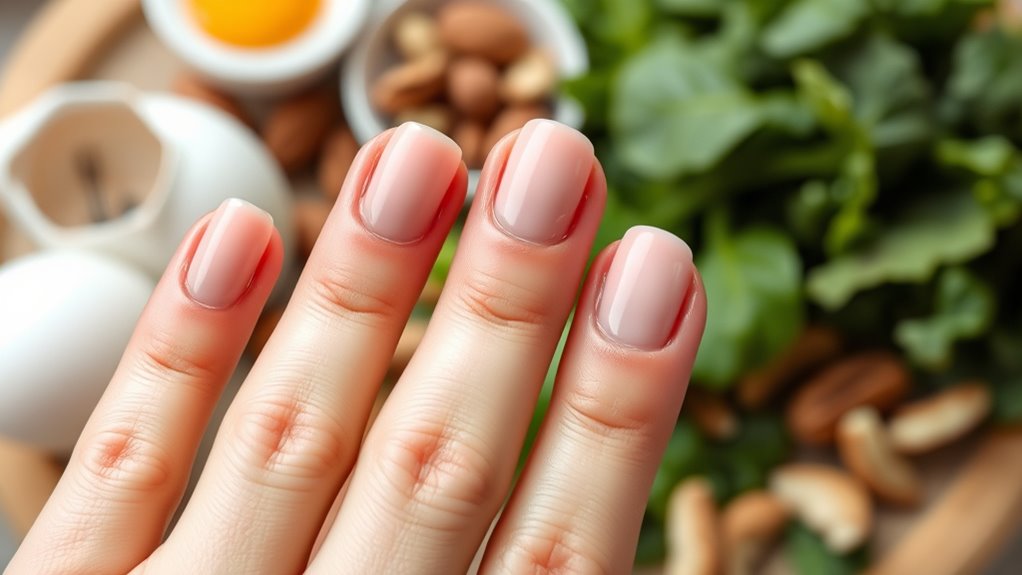
Maintaining good nutrition and adopting healthy lifestyle habits can considerably boost your nails’ keratin production. To support this, focus on a balanced diet rich in protein, biotin, and vitamins like A, C, and E. These nutrients are essential for keratin synthesis. Consider incorporating dietary supplements, such as biotin or collagen, to enhance keratin levels further. Additionally, using topical treatments with keratin or nourishing oils can strengthen your nails from the outside.
Here are three tips to maximize keratin health:
- Eat protein-rich foods like eggs, nuts, and lean meats.
- Take dietary supplements tailored for nail health.
- Regularly apply topical treatments to boost nail resilience and hydration.
Common Nail Issues Linked to Keratin Imbalances
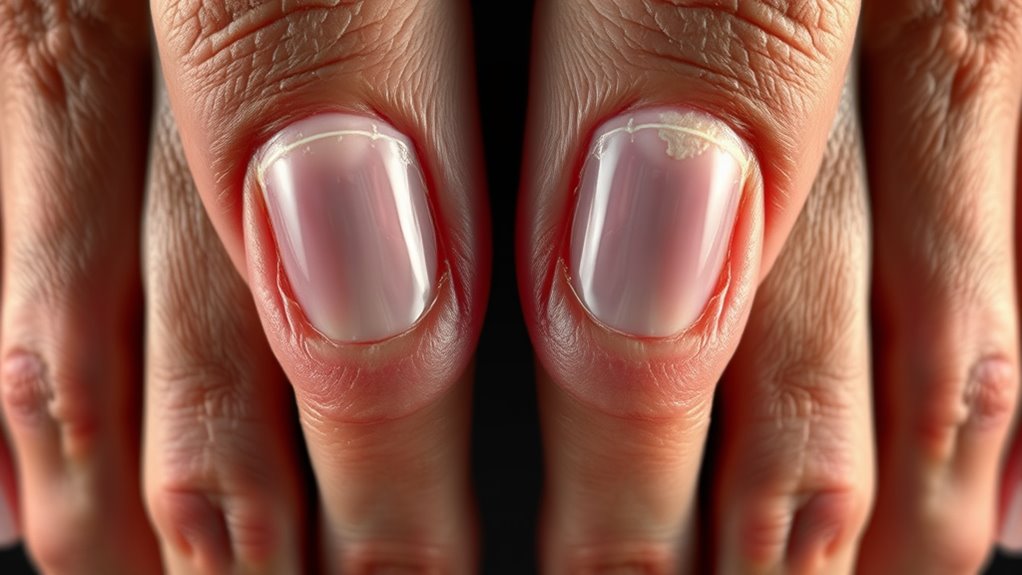
Have you noticed your nails becoming brittle, ridged, or peeling unexpectedly? These issues often signal keratin imbalances in your nails. When keratin production is disrupted, your nails may become more prone to damage and infection. Nail polish effects, like frequent removal or harsh formulas, can weaken keratin and exacerbate problems. Additionally, fungal infections thrive in compromised nails, leading to discoloration and deformity. If your nails are peeling or ridged, it’s a sign your keratin isn’t forming properly or is being over-processed. Addressing these issues involves balancing keratin levels through proper nutrition and avoiding damaging nail habits. Recognizing these common nail issues linked to keratin imbalances helps you take proactive steps to restore healthy, resilient nails.
Frequently Asked Questions
Can Keratin Treatments Permanently Improve Nail Strength?
Keratin treatments can temporarily improve your nail strength, but they don’t offer permanent results. The longevity effects of these treatments vary, often lasting a few weeks to a few months depending on your nail care routine. While they help smooth and strengthen your nails in the short term, regular maintenance is necessary to sustain the benefits. Keep in mind that over time, natural nail health depends on proper care and avoiding damage.
How Does Aging Affect Keratin Production in Nails?
As you age, your body experiences an age-related keratin decline, which can lead to weaker, more brittle nails. Hormonal impacts also play a role, as shifts in hormone levels may reduce keratin production. This means your nails might become thinner and more prone to damage over time. To counteract this, you can focus on nourishing your nails with proper nutrients and consider treatments that promote keratin health, helping maintain stronger nails despite age-related changes.
Are There Natural Remedies to Boost Keratin in Nails?
Did you know that nutrient deficiency affects over 30% of people worldwide? To naturally boost keratin in your nails, try DIY remedies like coconut oil or biotin-infused masks. Additionally, incorporate dietary sources such as eggs, nuts, and leafy greens into your meals. These simple steps nourish your nails from within, promoting stronger growth and healthier appearance without harsh chemicals. Consistency is key for noticeable results.
Does Frequent Nail Polish Damage Keratin Layers?
Frequent nail polish can damage keratin layers, leading to keratin depletion. When you constantly apply nail polish, especially if you don’t use a base coat or take breaks, it can weaken your nails’ keratin structure. This results in brittle, thin nails that are more prone to breaking. To protect your keratin, give your nails a break from polish, use nourishing treatments, and opt for formulas free of harsh chemicals.
Can Keratin Deficiency Cause Specific Nail Diseases?
Keratin deficiency can lead to specific nail diseases because keratin is essential for maintaining nail strength and structure. When your body lacks enough keratin, your nail health suffers, causing issues like brittle, ridged, or peeling nails. You might also notice increased breakage or fungal infections. Ensuring adequate nutrition with keratin-rich foods or supplements can help improve your nail health and prevent these problems caused by keratin deficiency.
Conclusion
By understanding how keratin gently guides your nails’ strength and grace, you can nurture their natural beauty. Supporting healthy keratin levels through good nutrition and care helps your nails shine softly and withstand everyday challenges. Remember, a little patience and kindness to your nails go a long way—like tending to a delicate garden. Embrace this journey, and your nails will thank you with their quiet resilience and subtle elegance.


